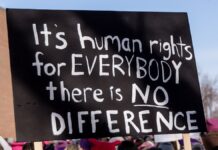If you thought you were done hearing about controversial artist Ayanda Mabulu for the year, you were wrong. Mabulu’s work is being dually exhibited with Vusi Beauchamp at the Kalashnikovv Gallery in Braamfontein in an exhibition called ‘Freedom of _ _ eech’ . This time, he uses Fezekile Kuzwayo or Khwezi – commonly known as the woman who accused President Jacob Zuma of rape in 2006 – in an artwork.
‘Freedom of _ _ eech’ refers to the Secrecy Bill or the Protection of State Information Bill as well as “freedom of speechâ€. The Secrecy Bill was passed in 2013 in the National Assembly after public outcry. There were allegations that the bill would interfere with transparency and mask corruption.
Mabulu is a controversial artist. The self-taught artist’s work focuses on social upheavals and the politics of the black body. He is known for causing outrage depicting Jacob Zuma’s phallus and/or prominent and powerful people in vulgar sexual positions.
In April, his painting of Jacob Zuma raping Mandela while Mandela was seated in his lap
made headlines. Last year, Mabulu painted his take on state capture by depicting Zuma performing a sex act on a naked Atul Gupta in the cockpit of an aircraft. The ANC had condemned last year’s exhibition saying the artist was abusing his right to freedom of expression.
His paintings show a lack of sensitivity for sexual violence on men. They also lack sensitivity for rape and sexual assault survivors in general. While I understand that art doesn’t have to be a certain way; art can be beautiful or gruesome or evocative, it can force people to have uncomfortable conversations. However, exploiting sexual violence as a metaphor in artwork leaves a bitter taste in my mouth.
When asked by the Mail & Guardian about his affinity towards equating male-on-male sex and rape with corruption, Mabulu said he doesn’t use metaphor. “If you think and look at that as a metaphor, then it is a direct one. IsiXhosa asitolikwa [you cannot translate isiXhosa]. There’s no beating around the bush when it comes to this,†he said.
Mabulu also doesn’t feel that his paintings lack sensitivity to rape victims. “I’m happy when someone who has been raped feels a particular way about a painting that is depicting rape,†he said. “By doing that, in our own language we say sithunuka islonda [agitate the wound]. The more you peel that wound the easier it is for you to heal.â€
Mabulu is not the only artist who has drawn the ire of certain crowds for painting the president’s penis.
In 2012, Brett Murray famously painted The Spear – a portrait of Zuma in the style of a Soviet-era poster which also exposed his penis. Murray drew inspiration from Viktor Semyonovich Ivanov’s poster titled Lenin Lived, Lenin is Alive, Lenin Will Live. The Spear was exhibited with various pieces critical of the ANC, and suggested corruption and bad governance. The ANC wrote to the Goodman Gallery and asked them to take the painting down. They didn’t as they felt this decree violated freedom of artistic expression. Gwede Mantashe said, “[The Spear] says that black people feel no pain and can be portrayed walking around with their genitals in the open. They are objects of ridicule.â€
Brett Bailey’s Exhibit B, a performance piece, was cancelled in London in 2014. The exhibition replicated the “human zoos†of earlier colonial times. It was meant to invite liberals to feel the “discomfort†of their colonial history while fawning over the naked and prostrate black body. Critics said the exhibition reproduces the idea that black people are passive agents used for white people to speak to each other.
Both artists used black bodies to make point about politics. Murray said he used them as a form of activism to show how corruption and guile undermine the work done by struggle heroes. Bailey defended the exhibit and said it was about about love, respect and outrage. Bailey said its main focus was “racist and xenophobic policies in the EU, and how these have evolved from the state-sanctioned racism of the late 19th centuryâ€.
In Mabulu’s, a large canvas shows a clothed Zuma with his phallus, Nkosazana Dlamini-Zuma being penetrated by a rolled-up ANC-headlined newspaper. In the background, the back of a naked Kuzwayo (using imagery from Bailey’s Exhibit B) and other women and girls are pictured. Text on the side of the artwork reads: “In this dog we fucked even with his bastard and prostitute he went on to rape khwezi and now his ex wife wants us to vote ourselves into rape kingdom rapedom”.
On the one hand we must never forget about Kuzwayo and that our president was acquitted of rape. However, we cannot reduce Kuzwayo to the woman who accused Jacob Zuma of rape.
In her book, “Khwezi†Redi Tlhabi introduces us to Kuzwayo. She was a woman with hopes and dreams like any other. We cannot reduce any rape survivor to what their body has endured. His artwork remembers Kuzwayo as Khwezi – the woman who went into exile after a gruelling court case – and denies her the dignity and autonomy she had as a woman.
It feels like Mabulu is using her to further his weird obsession with Jacob Zuma, his phallus, and the extended rape metaphor he is using to depict what Zuma is doing to the country. Ironically Mabulu said: “Rape is not a metaphor. Rape is real. Khwezi was raped.†Yet he continues to throw the rape metaphor around like confetti.
When Zapiro drew the cartoon depicting gang rape as a metaphor earlier this year, The Daily Vox said using rape metaphor isn’t smart or insightful – it’s tone deaf and it normalises rape culture. In a country with such high rape statistics, this isn’t cool. In South Africa, an average of 116 rapes (using current police statistics divided by the number of days in a year) are reported in a day. In September, Statistics South Africa released its Victims of Crime survey for 2016/2017 which showed that sexual offences increased exponentially by 110% since the previous year. As a society with a rape problem, we need to adjust our attitude toward it accordingly.
Metaphors are important. Writing for the Daily Maverick, Rebecca Davis explored what linguists say of the way metaphor shapes public understanding. George Lakoff wrote a paper in 1991 titled Metaphor and War explaining how the US government used certain metaphors to frame the public understanding of the situation in Iraq so that it systematically concealed the horrific consequences of the Gulf War.
Rape is not a metaphor; it’s not comedy or satire, it is a lived reality and a brutal one. Being flippant about it normalises rape and perpetuates rape culture. It dehumanises the trauma that survivor suffered and continue to suffer. Survivors of sexual violence deserve dignity. Women deserve dignity.
Ayanda Mabulu can carry on making his vulgar and attention-seeking art – that’s what freedom of artistic expression is about – but let Fezeka Kuzwayo rest in peace. Let the survivors of sexual violence be in peace.
The exhibition will run until Saturday, October 21.









